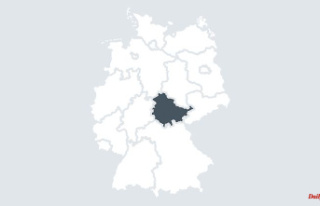The current year was the warmest on record. Temperatures were more than two degrees above average. At the same time, just under 85 percent of the average amount of rain fell. One of the reasons was an unusually stable high pressure situation in summer, as explained by ntv meteorologist Björn Alexander.
ntv: How extreme was the weather year 2022?
Björn Alexander: Measured on a scale of 1 to 10, we in Germany are easily in the top range. In terms of sun and heat in particular, the weather year 2022 is even at the top.
What does that mean specifically?
We are currently 2.23 degrees above the long-term average temperature. This means that 2018, the previous record holder, has been relegated to second place with an increase of 2.21 degrees. And because the last few meters of the old year were record-breakingly mild and sometimes stormy, the trend also ended up pointing upwards. The colleagues of the German Weather Service will certainly announce the exact deviation in the new year.
There are also records for the sun?
At the moment we are already at more than 2200 hours of sunshine in Germany. We have easily surpassed the previous record years of 2018 with 2015 hours of sunshine and 2003 with 2014 hours of sunshine. March 2022 in particular triumphed in the sun balance.
What does the solar yield say?
With almost 240 hours of sunshine, March was more reminiscent of midsummer than the first month of spring. The downside of the coin, which plays into the hands of regenerative energies in the field of photovoltaic systems, is unfortunately being felt again in the water balance. For example, March had just 15 liters of rain per square meter and thus barely a third of the monthly target.
Where was it the driest over the year?
In the east and north-east in particular, the rain balance is sometimes devastating. The driest place is Gardelegen-Lindstedterhorst in Saxony-Anhalt, with just over 300 liters of rain per square meter - this corresponds to barely 60 percent of the long-term rain yield. Meanwhile, it was the wettest in the south of our country. Balderschwang in Bavaria did not get the full rain yield with 90 percent of the annual target. However, this still corresponds to over 2100 liters per square meter.
What is the rain average for the whole of Germany?
All in all, a good 670 liters of rain per square meter fell in Germany in the 2022 weather year. That is around 85 percent of the long-term average.
Doesn't that sound so little?
Measured against the driest years, it is not. The years 2018 with 75 percent or, for example, 1959 with 68 percent were much more dramatic. However, the temperatures were higher this year and at the same time a lot more evaporated. In addition, the temporal distribution of the rain was sometimes catastrophic.
That means?
Ironically, in the hottest months, there was an enormous rain deficit. For example, the weather stations in the direction of the Eifel recorded almost no rain at all in July 2022.
Why was that?
This was due to an ongoing high pressure situation over Western Europe, which, for example, also brought France an exceptionally dry and hot summer and in Germany ensured that the river levels in some cases slipped into new record levels in the summer.
Is that unusual?
Actually already. It is a development in water levels that usually only occurs in late summer or autumn and which was fortunately slowed down this year by a September that was far too wet. Basically, since the drought year 2018, we have been putting off the drought problem in the deeper soil layers in some regions, making our water balance extremely vulnerable to longer dry phases. In this respect - and here we are again with the 85 percent rain in 2022 - the precipitation deficit has a number of direct negative effects.
What else was particularly noteworthy in the weather year 2022?
Here I would clearly see the heatwave around July 19th and 20th. First of all with our neighbors in Western Europe. Here the extreme heat bubble with over 40 degrees first advanced very far to the north, before it also became historic here in Germany.
how hot was it
With 40.1 degrees in Hamburg-Neuwiedenthal, the 40 degrees was cracked so far in northern Germany than since the beginning of regular weather recordings. In addition, 40.1 degrees was the highest temperature of 2022 in Germany.
What are the causes of these heated weather caprioles?
In my opinion, primarily due to dwindling momentum and thus longer-lasting weather conditions. One of the consequences of this is that warm air bubbles from southern latitudes can simply be routed northwards and sometimes more sustainably. A trend that has unfortunately intensified over the last few decades and will continue to do so.
Finally, when was it coldest?
The cold wave in the second third of December 2022 marks the low point of temperatures, often with lows below minus 10, sometimes even below minus 15 degrees. The lowest temperature was reported by Germany's highest mountain, the Zugspitze, at almost 3,000 meters and a low of minus 22 degrees. The coldest city was Neuburg an der Donau with minus 19.3 degrees. The night of December 18 was just as icy at the Heinersreuth-Vollhof weather station in the Bayreuth district in Upper Franconia.












